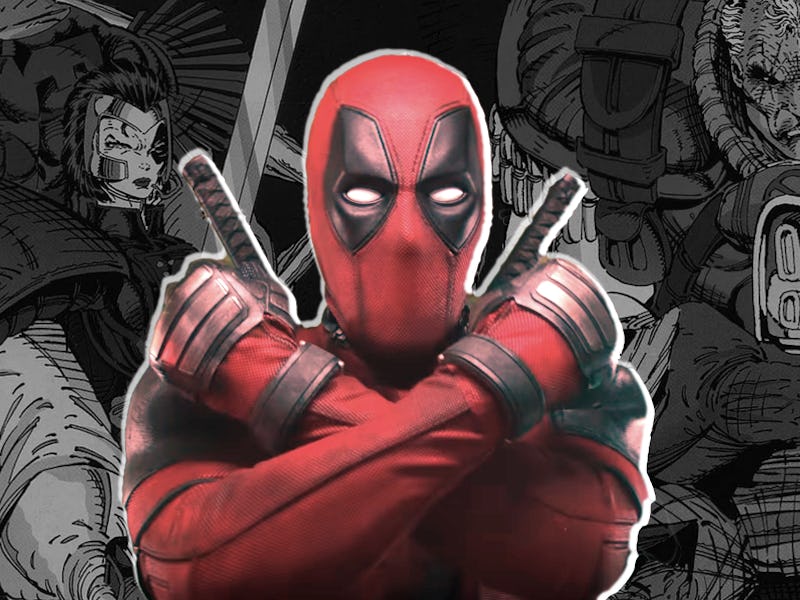How 'X-Force' Changed Comics, According to Deadpool Creator Rob Liefeld
'Deadpool 2' introduces the X-Force. Here's how they changed comics two decades ago.

For awhile, it looked like there was no stopping Thanos. Then, Deadpool came roaring back, slicing and dicing bad guys in Deadpool 2, an R-rated sequel to a movie that stuck out like a scarlet thumb. In its opening weekend on May 18, Fox’s Deadpool 2 dethroned the Disney/Marvel epic Avengers: Infinity War from its spot at the top of the domestic box office, grossing $125 million and making more than hits like Spider-Man: Homecoming, Thor: Ragnarok, and Justice League made in their first couple days. Irreverence, it seems, pays off.
But Deadpool did lift one strategy from his MCU frenemies: He didn’t come back alone. In Deadpool 2, the snarky anti-hero assembles his own avengers, a group of mutant he dubs “X-Force” who — spoilers! — don’t all make it out in one piece. Still, Deadpool 2 is the start of something new, with X-Force coming in the future. But anyone who read the X-Force comics back in the day may already know the power of change that the team’s name and legacy commands.
“I told Fox for years, ‘There’s gold in these hills,’” Deadpool and X-Force creator Rob Liefeld tells Inverse at a meet-and-greet in Manhattan a week before the film’s release. “And then they go, ‘Rob, there was gold in these hills!’”
Though the movie X-Force differs from the comic book X-Force, who debuted in issue #100 of New Mutants in 1991, the concept remains the same: Led by Cable, the X-Force are mutants who carry out missions with lethal efficiency, something you’ll never see from the image-conscious X-Men. It was this distinction Liefeld sought to capitalize, to shake up what they saw as a staling status quo.
“The comics had become very dull and boring,” remembers Liefeld. “The guys we looked up to were on top for a very long time, and you could see they were long in the tooth.” He respectfully name-drops pros of the era like John Byrne, as favorites who “were running out of steam.”
“Eventually, whether it’s a musical act or athlete, things run their course,” he says. “We came in. We had a new voice, a new style.”
Left: First issue of 'The X-Men' by Stan Lee and Steve Ditko. Middle: 'Giant Sized X-Men' #1, the first issue from Chris Claremont. Right: 'X-Force' #1 by Rob Liefeld.
It was all in the aesthetics for Liefeld. “Show me the mutant world prior to me,” he challenges. “I brought gear. All my characters were weaponized. Futuristic guns, swords, throwing knives, belt pouches, cybernetic appendages. Everything I was doing was visceral. Visible. I laughed when my editors said, ‘Hey Liefeld, mutants have powers.’ What’s better than a gun, with your power?”
Uncannily, Liefeld’s style came at the right time, falling in line with an excessive aesthetic that defined 1990s pop culture. The X-Force came months before Nirvana’s grunge masterpiece Nevermind, before James Cameron’s Terminator 2: Judgment Day, and around the release of video games like Duke Nukem and Street Fighter II. The zeitgeist was validated when New Mutants sales boosted under Liefeld. Issue #98 of New Mutants sold 750,000 copies, a major number for a comic even back then. When the series became X-Force, the first issue sold a record five million copies. It was the highest-selling comic of all time, until the release of Jim Lee’s X-Men #1 later that summer.
Rob Liefeld, at his pop-up in Manhattan a week before 'Deadpool 2' hit theaters.
Liefeld confesses to Inverse that he was disinterested in the original X-Men, the ones introduced by Stan Lee and Jack Kirby in 1963. “I rejected the original X-Men,” Liefeld reveals. “I looked at it and put it back. Pigeon wings! I always thought, ‘Angel, what’s the purpose?’” It wasn’t until Chris Claremont revived the flatlining Marvel title, where he debuted a new group who looked way far more radical than the originals, that caught the attention of a young Rob Liefeld. It was in Claremont’s X-Men readers got to know Storm, Nightcrawler, Colossus, and Wolverine, who leaped over from The Incredible Hulk. “When Wolverine and Colossus and the aggressive X-Men came, that killed me.”
The X-Force, as they appeared in 'Deadpool 2.'
But, because Liefeld wasn’t interested in the original, iconic X-Men (at least not at first), he had room to go wild with his own heroes.
“It wasn’t like I was messing with sacred cows,” he says about Cable, Domino, and Deadpool, the big three of his creative canon and whom he calls the “big stars” of Deadpool 2. He also affectionately refers to them as his “kids,” second only to his real children. “These were characters no one had heard of, but were coming alive on the page and people were connecting with them. It changed my existence. It changed my life.”
The success of Deadpool in 2016, an R-rated superhero film made for a lean $60 million and grossed close to $800 million worldwide in the middle of February, could have been a fluke. But Deadpool 2 shows it’s not. Whether that means a resurgence for era-defining violence driven by nostalgia, or moviegoers are getting worn out by Disney’s family-oriented Marvel outings and want something different, remains to be seen. Either way, Liefeld thinks his outlandish characters will speak for themselves.
“You can tell people, or you can show people,” he says. “Showing always works stronger.”
Deadpool 2 is in theaters now.